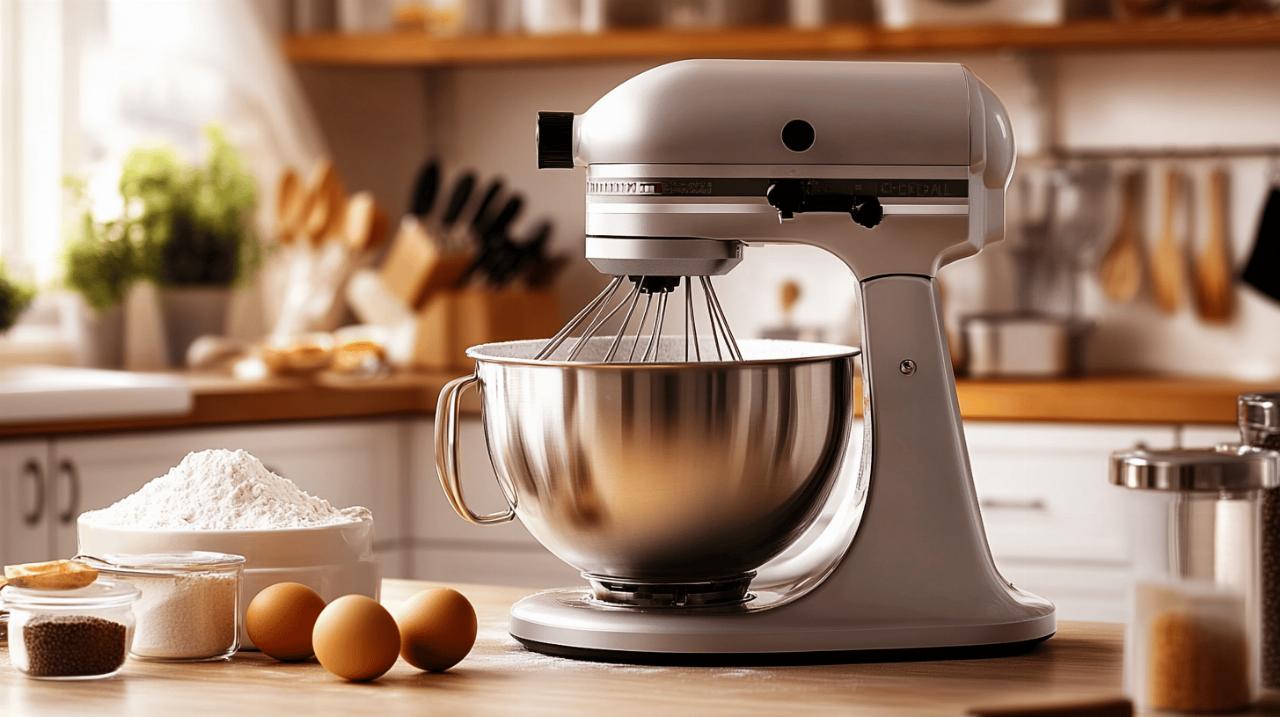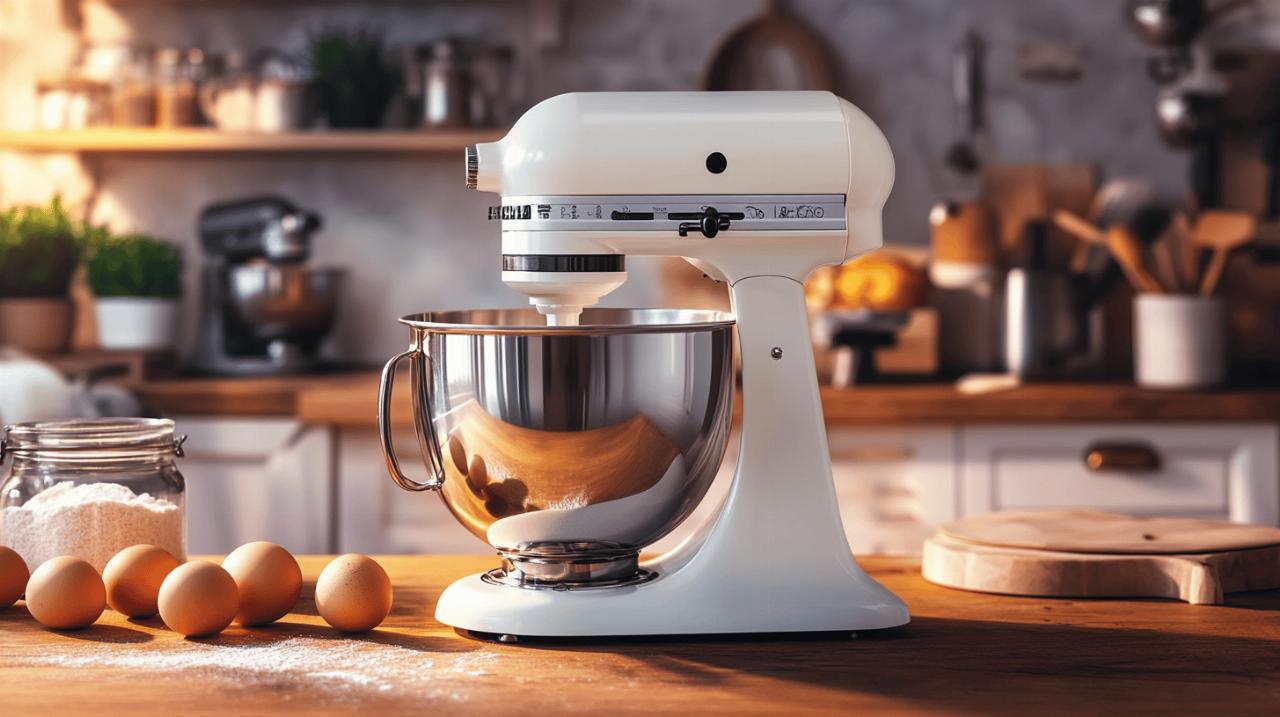Best Budget Stand Mixer 2025: Complete Comparison and Buying Guide for Home Bakers
For home bakers in 2025, finding the right stand mixer can transform your kitchen experience without requiring a small fortune. Whether you're whipping up the occasional Victoria sponge or tackling ambitious bread projects, the market offers impressive options across various price points. The best budget stand mixer combines reliable performance, practical features, and genuine value, making it an essential companion for anyone serious about baking. Understanding what separates a worthwhile investment from a disappointing purchase requires looking beyond marketing claims to actual performance in real kitchen conditions.
Understanding essential stand mixer features for home baking
Bowl capacity and motor power: what home bakers really need
The relationship between bowl capacity and motor power determines whether a stand mixer will handle your baking ambitions or leave you frustrated. Most home bakers find that a bowl capacity around four to five litres strikes the right balance, accommodating standard recipe quantities without overwhelming limited worktop space. However, capacity alone tells only part of the story. A generously sized bowl paired with insufficient motor power creates a mismatch that struggles with heavier mixtures. Aim for at least 600 watts when selecting a budget stand mixer, as this provides adequate strength for most home baking tasks including bread dough and thick cake batters.
The wattage specification reveals how much electrical power the motor can draw, but real-world performance depends on how efficiently that energy converts to mixing force. Some manufacturers compensate for lower wattage with better mechanical design, whilst others rely on brute force. Testing with actual bread dough and stiff mixtures exposes these differences quickly. Budget options ranging from 500 to 800 watts can perform admirably when engineered thoughtfully, making them viable alternatives to premium models boasting higher specifications. The key lies in matching the motor's capabilities to the bowl size and your typical recipes.
Planetary mixing action explained: why proper movement matters
The term planetary mixing action describes how the attachment rotates around the bowl whilst simultaneously spinning on its own axis, creating a pattern that covers the entire bowl interior. This movement pattern ensures thorough incorporation of ingredients without leaving pockets of unmixed flour or butter clinging to the sides. Cheaper stand mixers sometimes cut corners here, with attachments that follow simpler rotation patterns requiring frequent manual intervention with a spatula. When comparing budget stand mixer options, observe whether the beater reaches close to both the bowl bottom and sides throughout its rotation cycle.
Proper planetary action becomes particularly important when working with challenging mixtures like bread dough or dense cake batters. A well-designed system pulls ingredients from the bowl's edges into the mixing zone continuously, developing gluten structures evenly and incorporating air consistently. This explains why two mixers with similar specifications can produce noticeably different results. The geometry of the bowl and the precise calibration of the attachment's movement create subtle but significant differences in mixing performance. Budget models that successfully replicate this action deliver results approaching those from premium brands, making them excellent value for regular home bakers.
Top budget stand mixer brands compared: kenwood, kitchenaid, and klarstein bella
Premium Performance from Kenwood and KitchenAid: Are They Worth the Investment?
KitchenAid and Kenwood occupy the upper tiers of the stand mixer market, with even their entry-level models commanding substantial prices. The KitchenAid Artisan remains an iconic choice, combining reliable 300-watt performance with a 4.8-litre bowl and exceptional build quality. At approximately four hundred and fifty pounds, it represents a significant investment, yet its reputation for lasting decades makes the cost per year remarkably competitive. The tilt-head design simplifies access to the bowl, whilst the extensive range of available attachments transforms it into a versatile kitchen system beyond simple mixing tasks.
Kenwood approaches stand mixer design differently, with models like the Titanium Chef Baker offering more robust specifications including 1200 watts of power and dual bowl options. The Kenwood kMix provides an entry point into the brand at around two hundred pounds, delivering 1000 watts and solid construction that bridges the gap between budget and premium categories. Both manufacturers emphasise durability and long-term performance, backing their products with comprehensive warranties and readily available spare parts. For serious bakers planning extensive use, these brands justify their higher prices through longevity and consistent results across demanding applications from bread dough to delicate meringues.
Klarstein bella: quality mixing without breaking the bank
Klarstein represents a newer generation of appliance manufacturers offering appealing designs and respectable performance at substantially lower prices. The Bella line delivers attractive retro styling reminiscent of premium brands whilst keeping costs well below two hundred pounds. These mixers typically feature 1000 to 1200 watts of power paired with five to six litre bowls, providing specifications that match or exceed some premium competitors. The question becomes whether this combination of power and capacity translates to genuine performance when facing real baking challenges.
User experiences with Klarstein mixers reveal a more varied picture than with established premium brands. Many owners report excellent results for standard baking tasks, with the mixers handling cake batters and cookie dough admirably. However, sustained heavy-duty use, particularly with stiff bread doughs, exposes limitations in motor endurance and mechanical robustness that rarely trouble Kenwood or KitchenAid machines. For occasional bakers or those primarily making cakes and lighter mixtures, Klarstein offers genuine value. The trade-off involves accepting potentially shorter lifespans and less refined engineering in exchange for immediate affordability and attractive aesthetics that enhance rather than dominate kitchen spaces.
Attachments and Accessories: Getting More from Your Stand Mixer
Standard attachments: whisks, beaters, and dough hooks assessed
 Every stand mixer arrives with fundamental attachments designed for specific mixing tasks, yet their quality varies considerably across price points. The flat beater handles general mixing duties including cake batters and cookie dough, requiring sufficient rigidity to scrape ingredients from bowl sides without excessive flexing. Budget models sometimes economise here with thinner metal or plastic components that lack the substance needed for thorough mixing. The wire whisk incorporates air into egg whites and cream, with more wires generally creating finer, more stable foams. Count the wires and check their thickness, as flimsy construction produces disappointing results when whipping egg whites for pavlova or meringues.
Every stand mixer arrives with fundamental attachments designed for specific mixing tasks, yet their quality varies considerably across price points. The flat beater handles general mixing duties including cake batters and cookie dough, requiring sufficient rigidity to scrape ingredients from bowl sides without excessive flexing. Budget models sometimes economise here with thinner metal or plastic components that lack the substance needed for thorough mixing. The wire whisk incorporates air into egg whites and cream, with more wires generally creating finer, more stable foams. Count the wires and check their thickness, as flimsy construction produces disappointing results when whipping egg whites for pavlova or meringues.
The dough hook presents the greatest challenge for budget stand mixers, as bread dough exerts substantial resistance requiring both power and mechanical strength. Effective dough hooks feature designs that knead rather than simply stir, working the mixture against the bowl to develop gluten properly. Spiral hooks generally outperform simple C-shaped versions, though both can work adequately when paired with sufficient motor power. Testing revealed that some budget mixers struggle with full batches of bread dough, with motors straining or safety mechanisms stopping operation before proper kneading completes. If bread baking ranks among your priorities, verify that your chosen mixer and its dough hook can handle your typical batch sizes before committing to purchase.
Optional add-ons: pasta rollers, mincers, and specialist equipment
The versatility of stand mixers extends far beyond mixing when manufacturers design standardised attachment points accommodating specialist tools. Premium brands like KitchenAid offer extensive accessory ecosystems including pasta rollers, food processors, meat mincers, and even spiralizers, transforming the basic mixer into a comprehensive food preparation system. These attachments justify higher initial mixer costs by eliminating the need for separate appliances, though their value depends entirely on whether you'll actually use these capabilities. A pasta roller attachment costing one hundred pounds makes sense only if homemade pasta features regularly in your cooking repertoire.
Budget mixer manufacturers increasingly offer their own attachment ranges, though compatibility and availability sometimes create frustrations absent from premium brands. Verify what attachments exist for your chosen model and whether third-party alternatives fit, as some designs use proprietary connection systems that limit options. The attachment hub's power transmission also matters, with some budget models lacking the torque needed for demanding accessories like grain mills or meat mincers. Consider your realistic usage patterns rather than theoretical possibilities. A stand mixer excelling at core baking functions delivers better value than one with mediocre mixing performance but extensive accessory compatibility you'll rarely exploit.
Choosing the Right Stand Mixer for Your Baking Style
Heavy-duty bread making: selecting mixers for regular dough kneading
Bakers who regularly knead bread dough require stand mixers built to withstand sustained resistance and heavy loads. The ProCook stand mixer exemplifies this category, delivering 1800 watts of power through a six-litre bowl designed specifically for dough-intensive tasks. At approximately two hundred and fifty pounds, it provides serious capability without approaching premium brand pricing. The robust motor handles full batches of bread dough without strain, whilst the large bowl accommodates recipes yielding multiple loaves. For dedicated bread bakers, such specialised capability outweighs the benefits of lighter, more compact models better suited to occasional use.
Bowl-lift designs generally suit bread making better than tilt-head configurations, as they position the bowl more securely and handle heavier loads with greater stability. The KitchenAid Bowl-Lift Artisan demonstrates this advantage, though its premium pricing places it beyond strict budget categories. When evaluating mixers for bread baking, examine maximum dough capacity specifications rather than simple bowl volume, as these reveal the realistic quantities the motor and transmission can handle. Some manufacturers provide specific guidance about flour quantities for bread recipes, offering practical insight into capabilities. Remember that dough requiring extensive kneading stresses components far more than lighter cake batters, making build quality and motor reserves essential considerations for this demanding application.
Occasional baking and light mixing: finding your perfect match
Home bakers who primarily make cakes, biscuits, and occasional bread benefit from different priorities when selecting stand mixers. Lighter-duty models with smaller bowls and modest power specifications serve these needs perfectly whilst occupying less worktop space and costing considerably less. The Cuisinart Precision stand mixer illustrates this category brilliantly, offering a 5.2-litre bowl and 500 watts for approximately one hundred pounds. Its twelve speed settings provide fine control for delicate tasks like folding ingredients or slowly incorporating flour, whilst the compact footprint suits kitchens where storage space limits appliance size.
Ease of cleaning becomes more important for occasional bakers who may leave longer intervals between uses. Dishwasher-safe attachments and bowls simplify maintenance, encouraging regular use rather than leaving the mixer gathering dust. Tilt-head designs typically offer simpler access for cleaning and attachment changes compared to bowl-lift configurations, making them practical choices for less intensive baking schedules. The Smeg SMF03 combines these practical benefits with appealing retro styling that justifies its prominent worktop position even during periods of infrequent use. Consider honestly how often you'll actually bake and what types of recipes dominate your repertoire. A modestly specified mixer that perfectly matches your actual needs delivers far better value than an overpowered model whose capabilities you'll rarely exploit, regardless of impressive specifications or attractive pricing.










